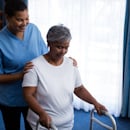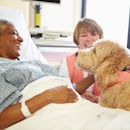
Patient Falls: Zero Tolerance
A fall is defined as an event that results in a person coming to rest inadvertently on the ground or floor or other lower level. A fall may result in an injury, and these injuries may be fatal or non-fatal though most are non-fatal (World Health Organization (WHO, 2018).
The elderly/frail patient is NOT the only patient at-risk for falling in a healthcare facility. ANY patient, of any age, and with any physical ability can be at-risk for falls due to physiological changes from:
- Medical conditions
- Medications
- Surgery
- Procedures
- Diagnostic testing
Unintentional falls are the leading cause of non-fatal injuries for all age groups over the age of 24 years. It is the second leading cause of injury in the age group 10-23 years and costs more than $50 million annually (WHO, 2018)
Did You Know:
- That falls with serious injury are consistently among The Joint Commission’s (TJC) top 10 sentinel events?
- Since 2009, 465 serious injury falls were reported to TJC
- About 63% of these falls resulted in death
To address these occurrences, federal, state, and local agencies have published guidelines and protocols. According to The Agency for Healthcare Research and Quality (AHRQ) “Fall prevention requires an interdisciplinary approach to care. Some parts of fall prevention care are highly routinized; other aspects must be tailored to each patient's specific risk profile. No clinician working alone, regardless of how talented, can prevent all falls. Rather, fall prevention requires the active engagement of many individuals, including the multiple disciplines and teams involved in caring for the patient. To accomplish this coordination, high-quality prevention requires an organizational culture and operational practices that promote teamwork and communication, as well as individual expertise” (Agency for Healthcare Research and Quality (AHRQ)[a], 2017).
Additionally, the AHRQ reports that while there are many studies that identify risk factors and related injuries, these studies have not been easily compared due to unlike study populations, lack of consistent and clear definitions, and the fact that there is a complex causal relationship between risk factors and fall occurrence (AHRQ [b], 2017).
Even though research cannot determine a causal relationship between risk factors and related injuries, research does support the use of risk assessment. Fall-risk assessment is an essential component of a comprehensive fall reduction and prevention program. The purpose of a fall-risk assessment is to identify a patient’s intrinsic risk for falling, minimize risk factors, and ultimately avoid falls and injuries. Ideally, a comprehensive fall risk assessment should be completed upon admission, when transferred to a new unit, or when the level of care changes, if a change in condition occurs, and after a fall.
The use of a reliable and valid tool for fall risk assessment is essential. It is important to note that risk assessment tools do not replace nursing judgment, nor does any one tool contain the specifics to identify every instance when a fall may take place. Do not use the score alone, but tailor the patient’s care plan to the individual risk factors.
To learn more about establishing and maintaining a successful fall prevention program, look for the new RN.com module: Fall Prevention Strategies or Hourly Rounding & Fall Prevention: A Winning Strategy.
References
Agency for Healthcare Research and Quality [AHRQ], (2017). Preventing Falls in Hospitals: A Toolkit for Improving Quality of Care.
Agency for Healthcare Research and Quality [AHRQ], (2017). Fall Response. The falls management program: A quality improvement initiative for nursing facilities.
Agency for Healthcare Research and Quality [AHRQ], (2017). Introduction and Program Overview. The falls management program: A quality improvement initiative for nursing facilities.
TJC. (2015). Sentinel event alert: Preventing falls and fall-related injuries in health care facilities.
World Health Organization (WHO). 2018. Falls.




